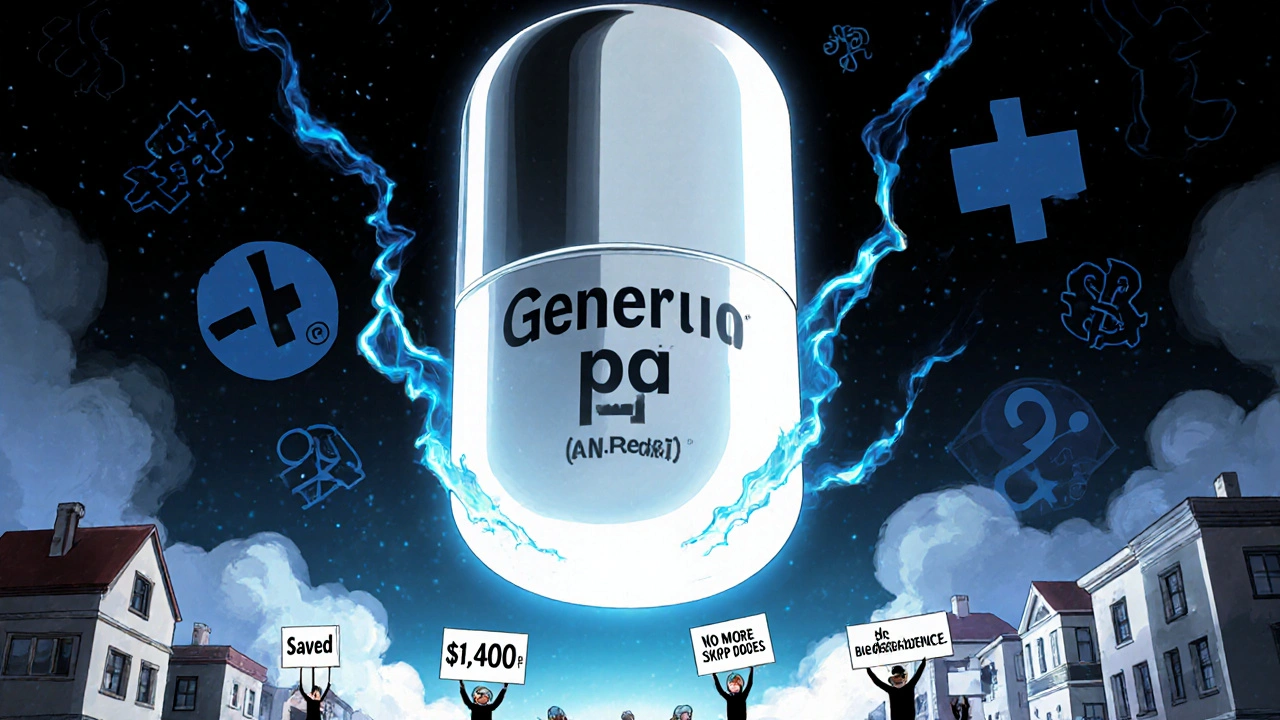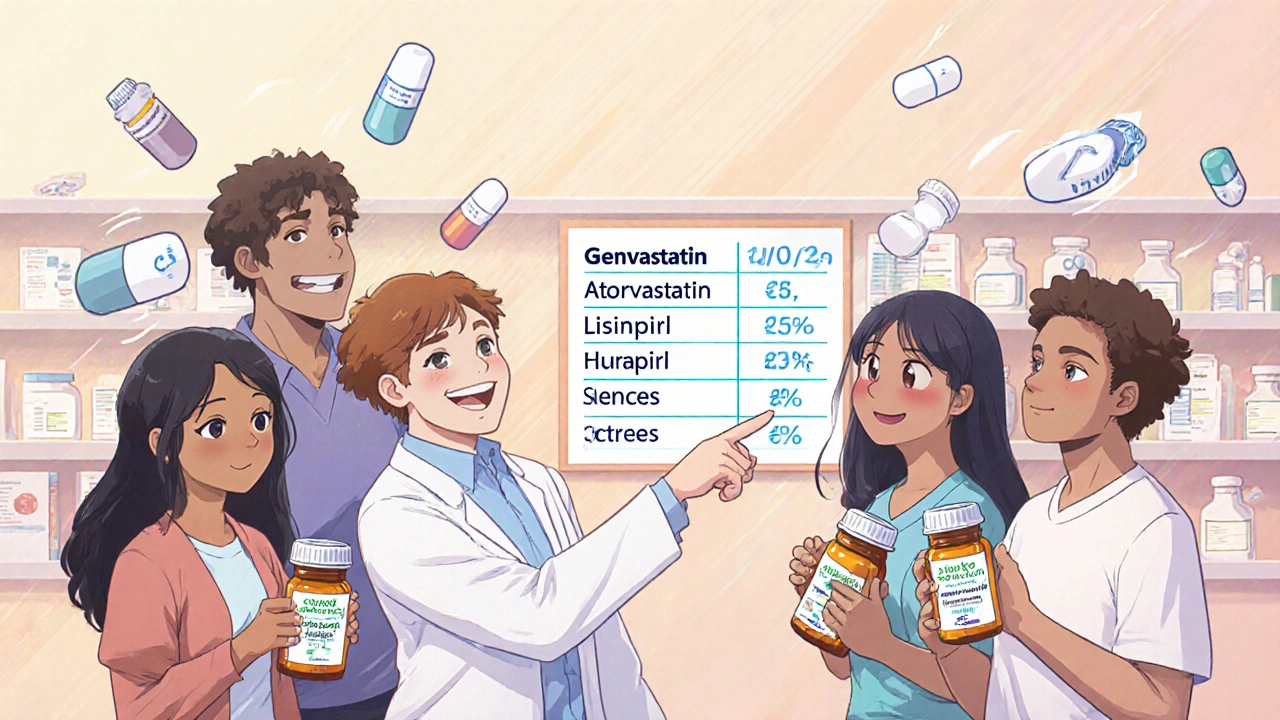Switching to generic medications isn’t just a smart move-it’s a life-changing one for millions of people who struggle to afford their prescriptions. If you’re paying $150 a month for a brand-name drug, you might be shocked to find out the same medicine costs less than $5 as a generic. This isn’t a rumor. It’s a fact backed by data from the FDA and real-world patient experiences.
What Exactly Are Generic Medications?
Generic medications contain the exact same active ingredient as their brand-name counterparts. That means if you take a brand-name drug like Lipitor for cholesterol, the generic version, atorvastatin, works the same way in your body. The FDA requires generics to deliver the same amount of medicine into your bloodstream at the same speed as the brand-name version. This is called bioequivalence. No guesswork. No compromises.What’s different? The color, shape, or filler ingredients. Those don’t affect how the drug works. You might notice a generic pill looks different, but that’s because manufacturers aren’t allowed to copy the brand’s appearance. The active ingredient? Identical. The effect? Identical.
How Much Money Can You Actually Save?
The numbers speak for themselves. On average, generic drugs cost 85% less than brand-name versions. That’s not a small discount-it’s a massive shift in affordability.Take a common blood pressure medication like lisinopril. The brand-name version, Zestril, might cost $120 for a 30-day supply. The generic? Around $4. That’s $116 saved per month. Over a year? More than $1,400.
One FDA report showed a single generic drug dropping from $47 per dose to under $2. The 30-day prescription cost fell from $1,400 to under $60. That’s a 95% price drop. Across the U.S., generics have saved patients over $2.2 trillion in the last decade.
Even if you have insurance, you’re still saving. In 2022, Medicare Part D beneficiaries found that 90% of the top 184 most prescribed generic drugs cost less than $20 at Costco. At many pharmacies, the cash price for generics is lower than your insurance copay. That means paying out-of-pocket might actually be cheaper.
Why Do Generics Cost So Much Less?
Brand-name drug companies spend years and billions developing a new medicine. They need to recoup that investment, so they charge high prices while they have patent protection. Once the patent expires, other companies can make the same drug. They don’t need to repeat expensive clinical trials. They just prove their version works the same way.This is called the Abbreviated New Drug Application (ANDA) process. It cuts out the most costly parts of drug development. That’s why generics can be sold for pennies on the dollar. The savings aren’t because generics are lower quality-they’re because the system is designed to encourage competition.
Over 100 companies now manufacture generic drugs in the U.S. That competition keeps prices low. The more manufacturers make a drug, the cheaper it gets.
Are Generics Really as Safe and Effective?
Yes. The FDA inspects generic drug factories the same way it inspects brand-name ones. The same rules apply for purity, strength, and stability. There’s no difference in safety standards.Some people worry they won’t feel the same effect. That’s usually not because the drug doesn’t work-it’s because of the inactive ingredients. Maybe the generic has a different coating or dye. That can cause minor side effects like stomach upset for sensitive individuals, but it doesn’t change how the medicine treats your condition.
There’s one exception: drugs with a narrow therapeutic index. These are medications where even a tiny change in dose can cause problems. Examples include levothyroxine (for thyroid) and warfarin (a blood thinner). For these, some doctors prefer to stick with one brand to avoid any variation. But even here, many patients switch successfully with proper monitoring.

How to Start Using Generics
You don’t need a PhD to switch. Here’s how to do it:- Ask your doctor if a generic is available for your prescription. Most of the time, they’ll say yes.
- When you get to the pharmacy, don’t assume the pharmacist will automatically switch it. Ask: “Is there a generic version?”
- Check the price. Sometimes the cash price at Costco, Walmart, or Sam’s Club is lower than your insurance copay. Use apps like GoodRx to compare prices.
- If your insurance won’t cover the generic, ask for a prior authorization or appeal. Many plans require this for brand-name drugs.
- Consider services like the Mark Cuban Cost Plus Drug Company. It’s a direct-to-consumer pharmacy that lists exact costs-no hidden fees. Median savings there? $4.96 per prescription.
Pharmacists are trained to help with this. Don’t be shy. They’ve seen it all.
Real Stories, Real Savings
Andrew Tighe from Phoenix switched his daughter’s medications to generics. She has an intellectual disability and takes multiple prescriptions. He started saving hundreds of dollars a month. “We were struggling to pay for everything,” he said. “Switching to generics made it possible to keep her on all her meds.”One Reddit user shared that their monthly medication bill dropped from $320 to $45 after switching to generics. Another said they used to skip doses because they couldn’t afford their brand-name insulin. After switching to the generic version, they started taking it regularly. Their blood sugar improved.
These aren’t rare cases. They’re everyday realities for people across the country.
What About Biosimilars? The Next Wave
Some drugs-like biologics used for arthritis, cancer, or autoimmune diseases-can’t be copied exactly. Instead, we have biosimilars. These are highly similar versions of complex biologic drugs. They’re not called generics, but they work the same way and cost 15-35% less than the brand.The FDA has approved dozens of biosimilars in recent years. As more biologics lose patent protection, we’ll see even more savings. This could bring down the cost of expensive treatments like Humira or Enbrel, which currently cost over $2,000 a month.

Myths About Generics-Busted
- Myth: Generics are made in poorer-quality factories. Truth: The same FDA rules apply. Many brand-name and generic drugs are made in the same facilities.
- Myth: Generics take longer to work. Truth: They enter your bloodstream at the same rate. The FDA requires this.
- Myth: Only uninsured people use generics. Truth: 90% of all prescriptions filled in the U.S. are generics-even for people with insurance.
What If Your Doctor Says No?
Sometimes, doctors are hesitant to switch. They might say, “I’ve always prescribed this brand.” But the science is clear: generics work. If your doctor resists, ask why. Is it based on evidence-or habit?You can also ask for a trial. Try the generic for a month. If you notice no difference in how you feel or how your condition is managed, stick with it. If you do notice something unusual, go back to your doctor. But don’t assume the generic doesn’t work just because it looks different.
Final Thoughts: It’s Not Just About Saving Money
Using generics isn’t just a budget trick. It’s about access. People who can’t afford their meds skip doses, delay refills, or stop taking them altogether. That leads to worse health outcomes, more hospital visits, and higher long-term costs.Generics fix that. They make treatment possible for people who otherwise couldn’t afford it. They help keep chronic conditions under control. They reduce the burden on the entire healthcare system.
If you’re paying too much for your prescriptions, you’re not alone. And you don’t have to keep paying it. Ask for the generic. Compare prices. Talk to your pharmacist. Your wallet-and your health-will thank you.

